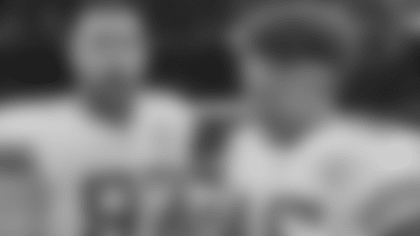Eagles fans love good defense.
Some of the most revered names in the history of the franchise: Reggie, Bednarik, Dawk, Trot, Jerome, Joyner - I could keep going, are remembered so fondly for a reason. Great defensive coaches like Buddy Ryan were the toast of the town and before the arrival of Jim Schwartz this offseason, Eagles fans have been starving for a nasty, aggressive defense that pressured quarterbacks consistently and brought a physical style of football back to the city. They haven't seen a scheme like that since the days of Jim Johnson, where a mix of aggressive run defense and zone pressure attacked opponents from every which way was the standard.
When you study a Mike Zimmer defense, you see a lot of the same hallmarks of Johnson's scheme. With Zimmer, the head coach of the Minnesota Vikings, it all starts with their aggressive pressure package. The foundation of what they do is based on what is termed as A-gap pressure, which is basically attacking a quarterback right up the middle. A gaps are the two spaces directly to the left and right of the center, between the two guards. The reason for this is simple, the A gaps provide the shortest path to the quarterback. By constantly threatening that space, Zimmer's teams are always aiming to be in a quarterback's face and disrupting the action.
There's another layer to this because the A gaps are also where all of your protection schemes start. As an offensive line, you never want to allow free rushers up the middle because it's the easiest way to injure your franchise quarterback. For that reason, protecting the A gaps will always be priority No. 1 for protection schemes up front. So before the snap, if the defense shows pressure up the middle, the offense has to account for it. This is the key to remember when watching the Vikings on Sunday afternoon. Whenever I watch Zimmer's teams, it always brings me back to Jim Johnson and some of his teams' most memorable performances.
What Zimmer and Johnson developed in their respective schemes, and were so effective at, was the act of widening the defensive front with two wide defensive ends, a pair of 3-technique defensive tackles and two linebackers standing up close to the line of scrimmage in the A gaps. This act of the linebackers up over the center has been called "sugaring" or "mugging" the A gaps. This look is now commonly referred to as a "mug" Front, which you see from Minnesota in nearly every passing situation.
There are really only two ways to block this up if you're an offensive line. Neither are 100 percent effective. You have six potential rushers with only six blockers. You can either slide your protection, allowing your offensive line to take care of the A gap pressure, or you can block the A-gap blitzers with your running back and center. Teams will do it differently scheme to scheme, but those are the two main ways to look at it. There are pros and cons with both options.
Shot 1 - One way to block up #Vikings Double A Gap 'Mug' look up front, sliding protection. Have seen teams use this tactic in quick game pic.twitter.com/eo8RKXEKHP — Fran Duffy (@fduffy3) October 20, 2016
If you decide to slide it, you're essentially asking all of your offensive linemen to step in one direction. The direction in which they step determines the defender that each lineman is responsible for. If a defense runs any kind of stunt or twist, it shouldn't matter. Linemen aren't blocking men, they are blocking gaps. The downside to this is that you then leave your running back in the very vulnerable position of blocking an edge defender one on one. That's a matchup that, more often than not, a defensive coordinator will take every day of the week. In this case, that would mean a player like Everson Griffen against a player like Darren Sproles in protection. You're more likely to see this kind of protection if the offense is running a quick, three-step pass play where the ball comes out quickly, allowing the running back to just cut the defender.
Shot 2 - The other way? Use the Center & Running Back to block two LBs inside. Keep that in mind when watching the rest of these shots. pic.twitter.com/kg2VNSl3Xw — Fran Duffy (@fduffy3) October 20, 2016
The alternative is that if you have the running back and center account for the muggers, you get to maintain your "big-on-big" matchups between your tackles and guards against the defensive line. However, this means you have the potential for penetration inside because the running back has to travel some distance to step up in protection. You're not going to have your running back cut a blitzer directly in front of the quarterback, so you need him to step up with proper technique and take on a rusher with a full head of steam.
What makes this increasingly difficult to protect against is that just because you block it up one way or another, there is no guarantee that those two mugging linebackers actually blitz. It's far less common for both players to rush the quarterback on the same play, and this is the beauty of it all. Sometimes, both players may come. Or both players may drop. Maybe one blitzes and the other drops in coverage. Defensive ends may drop. Defensive tackles may drop. Zimmer loves to send edge pressure out of these looks. It's a shell game for Zimmer, who toys with offenses on a weekly basis because he forces them into predictable situations. He knows that if he lines up with two linebackers mugged in the A gaps, that you then have to call one of two types of protection. That makes offenses predictable, and he preys off of that predictability, which we will get to in a bit.
From a personnel standpoint, this scheme is enhanced because the "Jimmies and the Joes" are equally as good as the "X's and O's." The Vikings have an athletic defensive line that features three really disruptive defensive ends in Griffen, Brian Robison and Danielle Hunter. Minnesota spends more than 75 percent of its snaps in nickel. You'll often see on Robison slide inside on passing downs to get Hunter on the field. All three players are relentless against the run and the pass. Linebackers Anthony Barr and Eric Kendricks are also both fast, relentless and versatile pieces in the front seven.
When you have players with quality movement skills up front, it allows Zimmer to toy with how they're used. When they line up in these mug fronts, Kendricks and Barr don't always just rush straight up the field because they'll run lots of stunts and twists with them as well, adding another layer that your backs and offensive line have to prepare for in protection.
Shot 3 - Everything #Vikings do defensively is centered around the threat of A Gap Pressure. They want to get matchups vs RBs in pass pro. pic.twitter.com/A3xJMVze3U — Fran Duffy (@fduffy3) October 20, 2016
Here's a play from two weeks ago against Houston. It's second-and-10, and the Vikings come out in the mug front with Kendricks and Barr over the center. The Texans try to block the two muggers with their center and running back, but here is what you want to keep in mind.
In the recap from the loss to Washington, I explained that when an offense slides a protection one way, it's zone blocking to that side, and often man protection to the back side? That is in play here in this scenario. The center slides to his right, as does the right guard and tackle. They are in zone protection. The left guard is now manned up against defensive tackle Linval Joseph (No. 98) and the left tackle is manned up on Griffen (No. 97) outside. That means the running back is actually manned up on Barr inside, so when Barr slants inside, he starts to follow him. This plays right into Zimmer's hands.
Zimmer dictated to the offense one of two protections and then broke down that protection by looping defensive tackle Tom Johnson (No. 92) around into the A gap. Zimmer knows that the Texans are sliding the protection away from the back, who is manned up on Barr, which gives Johnson a free run at quarterback Brock Osweiler. The back makes a great play here, recognizing the looper and stepping up, but even still, this is a great matchup for the defense, a tackle one on one against a back in pass protection. Osweiler throws this ball for an 11-yard gain and a first down, getting the pass off quickly, but the scheme remains the same. This is the cornerstone of what Zimmer wants to do to offenses.
No. 1: Dictate the protection with a pre-snap look, forcing offenses to block a certain way.
No. 2: Attack that protection with the pressure scheme getting the best matchup he can, often on a running back in the backfield.
Shot 4 - #Vikings love to send edge pressure out of Double A gap look. RB is occupied, no one to block S Harrison Smith #Eagles pic.twitter.com/QzmMaro2Vh — Fran Duffy (@fduffy3) October 20, 2016
Later in the same series, it is second-and-7 and the Texans block up Minnesota's mug front the same way, with a running back and a center. This time, there's no stunt inside from Minnesota, but watch who is coming off the left edge. That's safety Harrison Smith (No. 22), who plays a very Malcolm Jenkins-esque role in this defense as a slot player, run defender and blitzer. With the running back occupied by blocking linebacker Anthony Barr inside, there is no one available to block Smith off the edge. Notice on the other side, the Vikings drop Griffen into coverage. They'll do this often. Smith gets through clean here for a hit on the quarterback which forces an incomplete pass.
Both mugged linebackers blitzed on those last two shots, but that is not always the case. The guessing game of who is coming and who isn't is a tough one to play, but over the last couple of years, teams began to catch on to what Zimmer's linebackers were doing at the snap of the ball.
Shot 5 - When #Vikings send just 1 LB inside, they typically read the center and try to make him wrong in protection. Results in LB vs RB pic.twitter.com/lac1cOI7MM — Fran Duffy (@fduffy3) October 20, 2016
This is in Week 2 against Green Bay, and the Vikings show their mug look on second-and-10. The Packers pick it up with their back and center inside, but only one of the linebackers attacks. On this play, it's Kendricks coming through the right A gap, with Barr falling off into coverage. Notice at the snap of the ball, that the center, No. 73 JC Tretter of the Packers, opens up to that side. This is one of the keys to Minnesota's front. When the Vikings only send one of the two mugged linebackers, they're typically going to send the linebacker who the running back is responsible for.
The defense knows that if the center opens his hips at the snap toward one defender, the back is responsible for the other. The Vikings' goal is to break down the protection to get a blitzer one on one against a back. That happens here, as Kendricks gets free to Eddie Lacy. At the same time, Smith comes off the far edge (once again away from the side of the back), as Robison this time drops into coverage down the seam. Aaron Rodgers drops back and hits his man for a 15-yard gain and a first down on this play, a quick-hitting throw over the middle.
Let's go back to how you would block this on a whiteboard because Zimmer has incorporated another wrinkle here that adds another dimension to this scheme.

This is a basic look of two wide defensive ends, two 3-techniques lined up outside the guards and two linebackers mugged over the center. Got it? Good. Now here's the wrinkle.


In the first picture, the 3-technique has his hand in the ground. In the second one, the 3-technique (Robison) is standing up. The Vikings began mixing in these looks last year, but Zimmer slides Robison inside on third down, which in itself isn't all that exotic. But when you stand him up as the 3-technique next to two mugged linebackers, that allows you to run even more twists and stunts up front. From an offensive perspective on a whiteboard, it looks exactly the same (check the whiteboard shot above), but this is where the X and O's separate from the Jimmies and Joes. The combination of pressure schemes multiply yet again. This makes things incredibly difficult for offenses.
Shot 6 - New wrinkle this year for Zimmer. Slides Robison inside to DT, stands him up next to mugged LBs. Creates busted protection for CAR pic.twitter.com/B8FoZxAONb — Fran Duffy (@fduffy3) October 20, 2016
It's fourth-and-10 against Carolina, and here's that look with Robison standing up with a mugged look inside. The Panthers, in an empty set, slide their protection toward the right. This should, on a whiteboard, leave defensive back Marcus Sherels free off the right side for a shot at Cam Newton. But this is the problem when facing a scheme like this. The communication is not there for the Panthers up front, and they allow Everson Griffen, Minnesota's most dangerous pass rusher, to come free at the MVP. Newton throws the ball up in desperation, and it's picked off by Johnson as the Vikings get a turnover.
Shot 7 - Robison standup up creates opportunities for stunts, but even when you block it up inside, #Vikings DL can win 1 on 1s outside. pic.twitter.com/YYVxsBWLYa — Fran Duffy (@fduffy3) October 20, 2016
Here's a play from earlier in the game with the same exact look pre-snap. You have the mug front, Robison standing up inside, but now you see the types of games they run up front out of this look. It's the same stunt we showed you on the very first play of this breakdown, but instead of a 320-pound defensive tackle looping it's a 265-pound defensive end. Zimmer attacks the protection from the left side, and he wins. Robison is in clean, but not only that. Both defensive linemen on the right side also win their one-on-one battles.
This brings up another challenge when facing this Vikings defense. Not only do you have to worry about blocking everything up inside, but that in turn takes you away from providing consistent help outside. That's what makes this week such an interesting matchup with rookie Halapoulivaati Vaitai at right tackle. The Eagles' offensive staff will surely give him help when they can, but he's going to have to win his share of one-on-one matchups in this game. He'll have a tough test against the likes of Griffen, Robison and Hunter.
Shot 8 - #Vikings DEs are relentless in everything they do. Everson Griffen plays sideline to sideline every game. pic.twitter.com/ka04vFinq8 — Fran Duffy (@fduffy3) October 20, 2016
This is a good example of Griffen's relentless nature. Quarterbacks all season long have been getting the ball out quickly against Minnesota's ferocious rush, so there were plenty of examples on tape of Griffen and the rest of the Vikings' defensive linemen sticking their foot in the ground and pursuing plays to the flat.
Shot 9 - Brian Robison is a technician w/ his hands, has a high motor, and finds ways to win week after week. Very good pass rusher #Vikings pic.twitter.com/6a7JJf3pdB — Fran Duffy (@fduffy3) October 20, 2016
Here's Robison winning off the edge against Green Bay's right tackle. The veteran is so good with his hands. He excels at getting inside the pads of opposing linemen and driving them into the backfield. Here he swipes the hands of the tackle, dips his shoulder and turns the corner, accelerating into Rodgers as he chops the ball to the ground to force a fumble and a turnover for a huge play late in the game.
Shot 10 - #Vikings personnel is so strong. Barr is a huge part of what they do. Double A look here, him against a RB is typically a mismatch pic.twitter.com/fgyITapuui — Fran Duffy (@fduffy3) October 20, 2016
Back to the mugged look, here's a play against the Giants where again the personnel comes into play. New York blocks the two muggers with its center and running back. Notice that Kendricks, who is matched up on the center, drops out while Barr blitzes. Barr was a dynamic pass rusher coming out of UCLA, so getting him matched up on a running back is a win. He uses his hands to beat another former Bruin, running back Paul Perkins, as he gets free to knock this pass to the ground on fourth down. Even if he doesn't get the sack, Barr's combination of first-step quickness and length allow him to disrupt in the backfield regularly as a blitzer.
Shot 11 - Eric Kendricks is rangy and a big coverage player for them. Even from Mugged look he can get out to flat to pick up a PBU vs RB pic.twitter.com/IJEqCNQsam — Fran Duffy (@fduffy3) October 20, 2016
On the other side of Barr is Kendricks (Mychal's younger brother), who also hails from UCLA and is a true sideline-to-sideline player. Kendricks has the ability to get to his spot in the flat quickly and knock a pass to the ground in coverage. Both Kendricks and Barr have outstanding range, allowing them to line up over the center before the snap and still get to their landmarks in coverage with ease.
As an Eagles fan, you may be thinking to yourself, "How are we going to win this game?" This is a great defense. There's no doubt about that. They're in the top echelon of the league in every major category. They don't allow big plays. The Eagles will likely have to find ways to matriculate the ball downfield. It could be from the quick game in empty sets, screen passes, double moves, these are all ways that teams have tried to move the ball on offense against this team. New York had some success with quick crossing routes over the middle of the field. It comes down to the formula that was so instrumental to the Eagles' success early this season - control the clock, don't turn the ball over and play good defense. Those will be keys for the Eagles on Sunday.
From a coverage standpoint, the Vikings are a very physical group. Xavier Rhodes, Terence Newman (the former Dallas Cowboys first-round pick is still playing at a starting-quality level) and Trae Waynes are disruptive corners on the outside. Captain Munnerlyn plays a ton of snaps inside as the Vikings' slot corner in nickel. It's a primarily zone coverage team, but on third-and-long, like most teams, they play man coverage, mostly Cover 2 Man.
Shot 12 - #Vikings are a big zone defense, but like most teams on 3rd down you see a lot of man. Here, "Cover 2 Man" nets them an INT. pic.twitter.com/ueMVypcnQU — Fran Duffy (@fduffy3) October 20, 2016
The Vikings are in Cover 2 Man on this play, with two safeties over the top and all of the man coverage defenders in trail position underneath to take away short throws. Osweiler tries to fit this ball in over the top to his slot receiver, but safety Andrew Sendejo steps up and makes the interception in the third quarter.
Shot 13 - Linval Joseph is really tough to move inside. Destroyed the Giants a couple of weeks ago. So disruptive vs run #Vikings pic.twitter.com/JNRF8bHJo6 — Fran Duffy (@fduffy3) October 20, 2016
Lastly, in the run game, defensive tackle Linval Joseph is an absolute monster. He's part of a pretty good rotation, especially with Robison sliding inside on passing downs, but on run downs he's an immovable object inside. Jason Kelce, Allen Barbre and Brandon Brooks will have to account for Joseph in the run game on Sunday.
Fran Duffy is the producer of "Eagles Game Plan" which can be seen on Saturdays during the season. Be sure to also check out the "Eagle Eye In The Sky" podcast on the Philadelphia Eagles podcast channel on iTunes. Prior to joining the Eagles in 2011, Duffy was the head video coordinator for the Temple University Football team under former head coach Al Golden. In that role, he spent thousands of hours shooting, logging and assisting with the breakdown of the All-22 film from the team's games, practices and opponents.






















